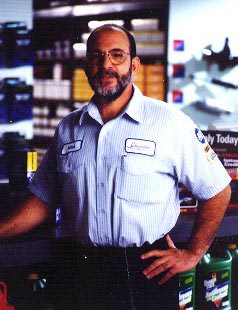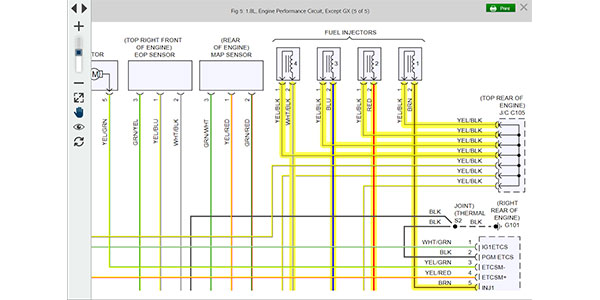 By Mitch Schneider
Contributing Editor |
It’s strange, the way things work out. How one seemingly isolated, non-related event can force you to confront the impossibly complex way virtually everything in our world is tied together. For instance, you wouldn’t think a cancelled speaking engagement would lead you down the rabbit hole of environmental responsibility, but it has and it’s a journey I think you really need to take with me. Not just because I’d like a little company, although company on a journey such as this is always nice, but because it is a place you really need to go.
For me, this journey began with a speaking engagement scheduled for the end of June. In fact, as I sit here, I’m supposed to be in Corpus Christi, TX, speaking for the Texas Independent Automotive Association at its 2006 annual meeting — an event scheduled months ago. However, approximately four weeks ago I was informed that the meeting had been cancelled and the focus of the entire association had been redirected to meet the dangerous and severe consequences of an unforeseen crisis. As a result, the meeting was put aside and with it my participation.
What kind of a challenge could turn an entire association inside out so quickly? What kind of a crisis could galvanize the membership to focus on virtually nothing else?
How about “Demand for Payment” letters from the Environmental Protection Agency — the smallest of which was $3,899 — appearing in the mailboxes of 25% of the members of the largest chapter in the association? Letters that, ironically enough, appeared in the mail the day after the association received an award for Environmental Excellence from the state of Texas.
Payment for What?
The letters demanded payment for their share of the cleanup required at an abandoned, 68-year-old refinery that had processed waste oil for some of the association’s members from 1988 until 1992 when it ceased operation, safe and harmless to the community.
What makes any of this worthy of discussion here? Any one of a number of serious considerations, not the least of which is the fact that this is a very real risk most shop owners face, but too often choose to ignore. And, why not? It’s a lot easier to ignore that risk than it is to accept responsibility for something — especially something as critical as hazardous waste management and disposal — when you have absolutely no authority or control over what happens to that hazardous material once it has left your care, custody and control.
With one head breathing the fire and smoke of compliance and environmental responsibility, and the other filled with the razor sharp teeth of compliance and accountability, this two-headed monster has become particularly threatening. What makes this beast even more terrifying is the fact it is immortal — it can and will never die. The federal government and the EPA have seen to that. They have determined that hazardous materials are a “Cradle to Crypt” responsibility, which means that you and I are responsible for those materials from now until the end of time. In fact, we can be held accountable even for those hazardous materials removed from our care, custody and control, long before there were any laws governing their handling or disposal!
What exactly does all that mean? Well, it can mean financial ruin if you haven’t managed the risks associated with these responsibilities intelligently, especially in light of the way the laws have been written and then interpreted.
I have taken an interest in this particular case for a number of reasons, the most personal of which is the ongoing battle that occurs here at our shop every time the bill for our pollution coverage appears in the mail. We spend more than $60,000 per year on a host of different insurance products to manage the risks associated with running a contemporary automotive repair facility. That’s a staggering sum for any small business, a potentially crippling expense for a business like yours or mine. I would be lying if I told you I smile a lot when I write those checks; I don’t. I can think of dozens of other things critical to the future health of this business and everyone involved in it I would rather spend that money on, but the potential damage any one of the many risks these policies protect us against more than outweighs the cost of being shielded from them.
I wince, bite my lower lip and write the checks. More than a decade ago, when service station operators and garage owners in Maryland were told they had to pay a portion of the cleanup cost of a landfill that was contaminated with “junk” batteries collected and disposed of decades before these laws had been enacted, that’s when I realized just how great our exposure really is.
That’s also when I realized how dangerous denial can be. As a result of that incident, I wrote a feature piece on environmental responsibility and the dangers associated with the receiving, managing and disposing of hazardous materials and the inequity of holding the service industry responsible as hazardous waste “generators” when, in fact, we are anything but.
The materials in question are “generated,” created by a manufacturing plant or refinery, and then sold to a wholesale distributor who in turn sells them to us. We accept those materials for resale and then make them available to the vehicle owner. They merely pass through our shops on their way to use in the vehicle and then on to some other facility. They are only ours for a very short time. We are no more or less “hazardous waste generators” than the factories that create them or the consumers who use them. Regardless of city, county, state and federal government agencies hold us responsible for the hazardous materials that move in and out of our shops from the moment they appear on-site and enter our care, custody and control, until the end of time as if they remained in our care, custody and control.
The cost of cleaning up an environmental “disaster” can be catastrophic. Aside from that, there is no guarantee that a “demand for payment” letter from the federal government will not be followed (or preceded) by a similar demand for payment from the state. Either of those could be accompanied by a civil suit based on exposure to contamination or property damage if the cleanup extends beyond the site’s property lines. And, this responsibility appears to pre-date any of the statutes governing environmental responsibility, holding us accountable for how these wastes may have been managed or abandoned long after their disposal.
As individuals, we have done little to protect ourselves financially; as an industry, we have done less to protect ourselves politically. When it comes to our government, we remain “out of sight” and “out of mind” because we have never come together to challenge these critical issues with one clear voice.
When all is said and done, these critical issues are the common threat that should have brought us all together years ago. But, unfortunately, that did not happen and the consequences are clear, especially to those shop owners in Texas.
The risk is significant and for that reason alone, clearly worthy of review. That review must include the nature of the risk, the need to protect ourselves against that risk, our responsibility with regard to managing or disposing of hazardous materials and, finally, our responsibility to protect ourselves, our industry and the environment — a challenge every one of us must acknowledge and accept if we are to respond successfully.
You can and likely will be held accountable for at least a portion of the cleanup cost associated with the restoration of any site where materials that passed through your hands were found. The list of materials that we use in the course of the work we do, as well as those we make available to the motorist is endless, and almost all of it is or can be considered hazardous. That list includes solvents, chemical cleaners and detergents, lubricants, batteries and battery media, plastics and waste of virtually every kind, including anything from cores to old engine blocks. And, your responsibility does not end with the way you handle these materials, it begins there. You are also responsible for the way everyone who handles those materials subsequently discharges their responsibilities!
I don’t know how you feel about accountability without authority or control, but as far as I’m concerned, it is more terrifying than a Freddy Krueger movie!
What This All Means
To me, that means managing HazMat risks aggressively. It means trusting only companies that have proven they are responsible when it comes to transporting and disposing hazardous materials. It means requesting and keeping copies of their licenses, permits and insurance policies on file. It means taking the time to ensure that the facility handling your waste materials has the proper permits and is not in violation of any of the statutes, rules or regulations pertaining to the handling and disposal of those materials.
It means paying attention to what they do and how they do it when they are on-site at your facility. If they are sloppy and careless while you are watching, they aren’t likely to be any more diligent or responsible when no one is around. It also means keeping all the appropriate paper work, manifests and receipts for any materials either delivered to or removed from your facility, as well as copies of all your old insurance policies.
It means never private-labeling hazardous materials, such as batteries, etc. They are much too easy to tie back to you after someone you may have sold that battery to years ago decides it’s too much trouble to dispose of it responsibly, instead choosing to bury it inappropriately at a local landfill!
It means removing or at least upgrading your underground tanks, if you haven’t already done so. And, if you haven’t done so, do so as soon as you can!
It means making hazardous waste non-hazardous if you can, through 1) incineration (waste oil heaters, as an example), and/or 2) recycling (parts cleaning fluid can be recycled). But, if you are going to incinerate waste or implement any new system to handle that waste, make sure whatever you are doing is consistent with local codes and regulations.
And, it means substituting new materials that are not hazardous in place of materials that are, if you can: such as the use of water-based solvents in place of chemical solvents.
Know and comply with federal, state and local EPA regulations. And, have emergency procedures in place to deal with spills or contamination that may occur at your facility. This includes proper training and on-going education for everyone on your staff. But, most of all, find an insurance professional you can trust — someone who is even more neurotic about protecting your assets than you are — and have them help you both assess and then respond to your exposure appropriately. That’s what I did. My agent has badgered me into compliance more than once and I sleep better at night because of it.
Finally, I implore you to get involved. Write your senator or congressperson. Let them know how terribly unjust it is to hold someone accountable for something over which they have little or no control. Let them know that being held accountable for actions or events that may have occurred long before there was any statute regarding those actions or events, as if those statutes were in existence at the time, is a violation of the spirit, if not the letter of the Constitution itself. Let them know these aren’t our hazardous materials. They are someone else’s, both before they arrive at our facilities and after they have been removed.
Have them explain how this is our responsibility and not the responsibility of the refineries or manufacturers who actually created these materials. And, while they are at it, have them explain how or why the vehicle owner remains exempt. I believe the reason we are singled out is simple: our industry is fragmented, and because it is fragmented, it is weak. Because we are weak, we are vulnerable. And, because we are vulnerable, it is easy to place this responsibility squarely on our shoulders knowing it is unlikely there would be the same kind of political fallout that would accompany forcing every manufacturer and motorist to share this universal responsibility equally with us.
If you can see the risk or recognize the responsibility, your course of action should be clear. Protect yourself with the appropriate insurance products. If you can’t afford to do that, raise your labor rate or charge a “Hazardous Materials Management & Disposal Fee.” If you belong to an association, get them involved. There is strength in numbers. If you aren’t a member of an association, join one. Then get them involved.
Most of all, try to remember that the old expression “out of sight, out of mind” doesn’t speak to the issue of environmental responsibility at all. Try to remember that the hazardous materials we handle are our responsibility from “Cradle to Crypt,” from the time they enter our facilities until long after they leave. And, for that reason alone we must remain vigilant and act responsibly always. But, remember that acting responsibly must include doing what is best for us and for our industry, as well as what is best for the environment, and that the two are not mutually exclusive. If you shield yourself against these risks appropriately, you don’t have to let something that is out of sight, drive you out of your mind.
Special thanks to: Debbie Hooge, executive director, Texas Independent Automotive Association; Howard Hammer, Howard J. Hammer Agency, Farmer’s Insurance; Karon Eva, senior underwriter, Zurich Environmental; and Liz Taggert, director of corporate marketing, Universal Underwriters Group.






